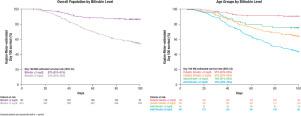Biology of Blood and Marrow Transplantation ( IF 5.609 ) Pub Date : 2020-03-19 , DOI: 10.1016/j.bbmt.2020.03.011 Selim Corbacioglu 1 , Nancy A Kernan 2 , Antonio Pagliuca 3 , Robert J Ryan 4 , William Tappe 5 , Paul G Richardson 6

|
Veno-occlusive disease/sinusoidal obstruction syndrome (VOD/SOS) is a potentially life-threatening complication of hematopoietic cell transplantation (HCT) that is traditionally diagnosed using Baltimore or modified Seattle criteria. Whereas the Baltimore criteria require the presence of hyperbilirubinemia (bilirubin ≥2 mg/dL) for a diagnosis of VOD/SOS, the modified Seattle criteria do not. Before approval by the US Food and Drug Administration, defibrotide was available in the United States through an expanded-access study (T-IND). The T-IND protocol initially required post-HCT diagnosis of VOD/SOS by the Baltimore criteria or biopsy but was later amended to include patients diagnosed using the modified Seattle criteria. This post hoc analysis examined the incidence of VOD/SOS with a bilirubin level <2 mg/dL before and after Day 21 post-HCT in T-IND patients enrolled following the amendment allowing for diagnosis by the modified Seattle criteria. Survival of adult and pediatric patients with or without hyperbilirubinemia and with or without multiorgan dysfunction (MOD) was also evaluated. Of 803 post-HCT patients with VOD/SOS enrolled following the protocol amendment, 181 (23%) had a bilirubin level <2 mg/dL and would not have been diagnosed if hyperbilirubinemia was required. The bilirubin level at diagnosis was <2 mg/dL in 165 of 331 patients (50%) diagnosed by the modified Seattle criteria and in 16 of 23 patients (70%) diagnosed by biopsy. VOD/SOS with a bilirubin level <2 mg/dL was more common in pediatric patients (29%), although it also occurred in adult patients (15%). Patients with hyperbilirubinemia had lower Day 100 survival (54% versus 87% in patients with bilirubin <2 mg/dL) and a higher incidence of MOD (41% versus 26% in patients with bilirubin <2 mg/dL). The incidence of treatment-emergent adverse events and serious adverse events was lower in patients with a bilirubin level <2 mg/dL. These results indicate that anicteric VOD/SOS occurs in both adult and pediatric patients post-HCT and can be diagnosed before and after Day 21 in both groups. The worse survival in patients with bilirubin ≥2 mg/dL suggests that requiring hyperbilirubinemia may result in a progressed disease stage associated with worse outcomes. Taken together, these results highlight the importance of awareness and the possibility of VOD/SOS in the absence of elevated bilirubin level.
中文翻译:

成人和儿童患者造血细胞移植后无黄疸静脉闭塞病/窦状隙阻塞综合征的发生率和去纤维肽的结果。
静脉闭塞性疾病/窦状隙阻塞综合征 (VOD/SOS) 是造血细胞移植 (HCT) 的潜在危及生命的并发症,传统上使用巴尔的摩或修改后的西雅图标准进行诊断。巴尔的摩标准要求存在高胆红素血症(胆红素≥2 mg/dL)才能诊断 VOD/SOS,而修改后的西雅图标准则不需要。在美国食品和药物管理局批准之前,去纤维肽可通过一项扩大访问研究 (T-IND) 在美国获得。T-IND 协议最初要求根据巴尔的摩标准或活检对 VOD/SOS 进行 HCT 后诊断,但后来被修改为包括使用修改后的西雅图标准诊断的患者。该事后分析检查了胆红素水平 < 在修订后登记的 T-IND 患者 HCT 后第 21 天之前和之后 2 mg/dL,允许通过修改后的西雅图标准进行诊断。还评估了有或没有高胆红素血症和有或没有多器官功能障碍 (MOD) 的成人和儿童患者的存活率。在协议修订后入组的 803 名 VOD/SOS 后 HCT 患者中,181 名 (23%) 的胆红素水平 <2 mg/dL,如果需要高胆红素血症则不会被诊断出来。根据改良西雅图标准诊断的 331 名患者中的 165 名 (50%) 和活检诊断的 23 名患者中有 16 名 (70%) 的胆红素水平<2 mg/dL。胆红素水平 <2 mg/dL 的 VOD/SOS 更常见于儿科患者 (29%),尽管它也发生在成人患者中 (15%)。高胆红素血症患者的第 100 天生存率较低(胆红素 <2 mg/dL 的患者为 54% 与 87%),MOD 的发生率较高(胆红素 <2 mg/dL 的患者为 41% 与 26%)。胆红素水平 <2 mg/dL 的患者治疗中出现的不良事件和严重不良事件的发生率较低。这些结果表明,在 HCT 后的成人和儿童患者中均发生黄疸 VOD/SOS,并且可以在两组的第 21 天之前和之后进行诊断。胆红素 ≥ 2 mg/dL 患者的生存期较差表明需要高胆红素血症可能导致疾病阶段进展,结果更差。总之,这些结果强调了在没有升高的胆红素水平的情况下意识的重要性和 VOD/SOS 的可能性。



























 京公网安备 11010802027423号
京公网安备 11010802027423号